While peatlands cover only 3% of the Earth’s total land area, they account for 30 % of the planet’s soil carbon storage. The cold, acidic, and waterlogged conditions commonly found in wetlands limit carbon emissions into the atmosphere that may result from the decomposition of their soil organic matter.

Image Credit: ABB
Furthermore, wetland ecosystems play a crucial role in absorbing CO2 through photosynthesis, effectively transforming them into carbon sinks under normal conditions. However, there is a looming threat that this balance may be disrupted due to the observed global warming phenomenon, partly attributed to the substantial emissions of anthropogenic greenhouse gases into the atmosphere.
By the end of the 21st century, Earth's surface temperature is expected to increase by 1 °C to 3.7 °C. This estimated warmer climate could encourage soil decomposition and turn peatlands from carbon sinks to carbon sources.
This could actually increase the global warming effect, as the significant amounts of carbon contained in peatlands would enter the atmosphere. Thus, it is crucial to comprehend the influence of climate warming on the carbon balance of peatlands.
The “Response of Peatland CO2 and CH4 Fluxes to Experimental Warming and the Carbon Balance” research article offers a summary of results from a peatland warming experiment executed by an interdisciplinary team of scientists from the Université d’Orléans.1
The authors hypothesized that the warming treatment would stimulate carbon input to peatlands via photosynthesis while simultaneously releasing carbon into the atmosphere through ecosystem respiration and CH4 emissions. This outcome could potentially diminish the overall carbon sink function of the peatland ecosystem.
Peatland Warming Experiment
To test these hypotheses, the scientists constructed 12 mesocosms by filling monolith cylinders (each 30 cm in diameter and 40 cm deep) with soil samples extracted from the French La Guette Sphagnum moss peatland. These cylindrical mesocosms were then positioned in holes dug at a study site near Orléans and were divided into two subgroups:
- Six mesocosms exposed to a moderate experimental passive warming treatment using transparent PVC open-top chambers (OTC).
- Six mesocosms subjected to ambient conditions in PVC chambers without OTC, serving as a control set.

Mesocosm cylinder. Image Credit: ABB
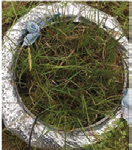
Mesocosm plot inserted in mineral soil. Image Credit: ABB
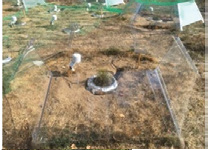
Implementation of warming treatment over mesocosm plot by clear open-top chamber. Image Credit: ABB
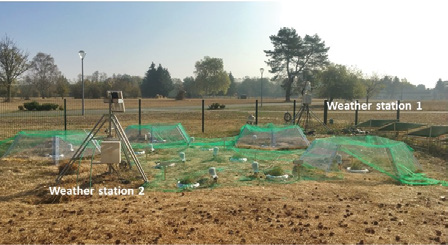
Study site with two weather stations (Li et al.). Image Credit: ABB
Natural precipitation was used as the main water supply at the site, supplemented during the summer drought by water from a drainage ditch located nearby. This ensured that the water table depth (WTD) – determined manually using piezometers – remained alike among all mesocosms.
Carbon fluxes were monitored using the static PVC chambers, which were equipped with a low-speed battery-operated fan to facilitate air circulation inside the chamber during measurements. Between measurements, the chambers were air-flushed to equalize the headspace concentration with that of the ambient air.
CO2 flux measurements were conducted using a non-dispersive infrared third-party instrument inserted into the chamber. CH4 fluxes were measured using an Ultraportable Greenhouse Gas Analyzer based on ABB’s patented Off-Axis Integrated Cavity Output Spectroscopy (OA-ICOS) technology.
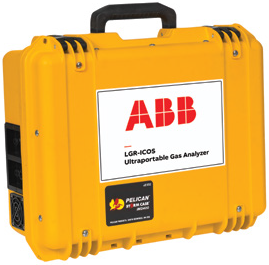
ABB OA-ICOS Ultraportable Greenhouse Gas Analyzer (GLA132-GGA). Image Credit: ABB
The CO2 and CH4 fluxes of the mesocosms subjected to the two treatments were monitored over a period of two years and modeled to establish an annual greenhouse gas carbon budget. This budget represents the net gaseous carbon accumulation/release rate of the ecosystem in relation to the various environmental (abiotic) and biological (biotic) parameters that were also measured during the experiment.
The abiotic parameters of the models included the water table depth (WTD) and the following additional measurements:
- Mesocosm soil temperature at different depths (5, 15, 30 cm)
- Peat surface water content at 5 cm depth
- Air temperature above soil surface
- Ambient air temperature and relative humidity
- Solar radiation of ambient environment
- Atmospheric pressure of ambient environment
- Precipitation
The probes and sensors used to monitor the abiotic parameters were connected to dataloggers in two weather stations installed on site. Two-thirds of the available data was randomly selected from each mesocosm treatment for model calibration; the rest was used to validate the model.
The conclusions of the experiment demonstrate that the experimental warming greatly enhanced the annual CO2 uptake through photosynthesis. This mainly occurred between April - May 2019 when the graminoid leaf count was higher under warming treatment than in the control sets.
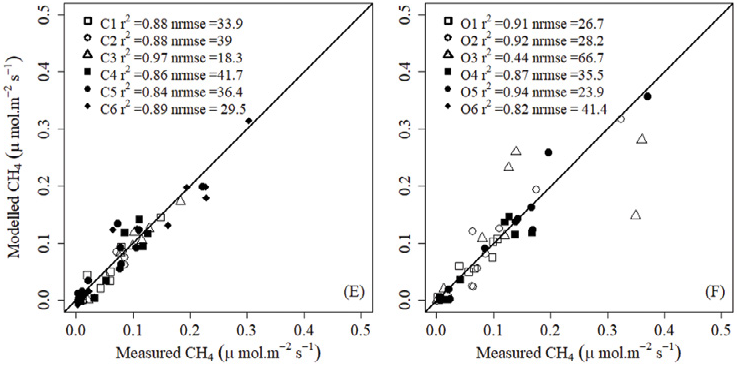
Comparison of the modeled versus actual values of CH4 emissions for replicates in control set (left) and under OTC warming treatment (right), showing the good performance of the CH4 emission models (Li et al.). Image Credit: ABB
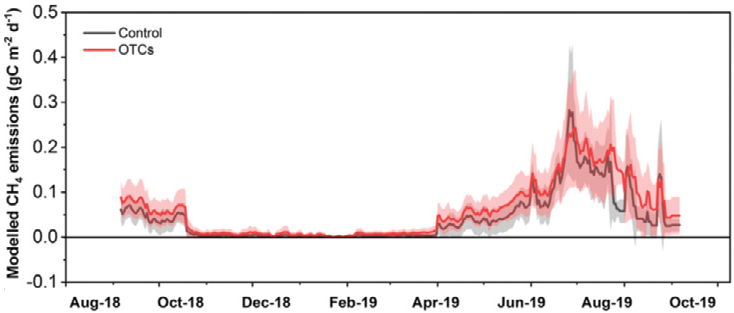
Modeled daily CH4 emission. Similar patterns observed for OTC and control plots indicate that the warming treatment has no significant effect (Li et al.). Image Credit: ABB
The experimental warming encouraged the growth of graminoids, which increased the plant biomass and enhanced the plant’s ability to remove CO2 from the atmosphere.
However, the warming treatment had minimal effect on CH4 emissions, which are predominantly controlled by the WTD. Increased emissions as a result of warming treatment were only seen in July 2019, when the water table was at its lowest point.
Throughout that time, the amount of water-saturated (anaerobic) peat decreased, and the aerobic layer increased, which led to the oxidation and emissions of CH4. Those CH4 emissions accounted for just 0.9-2.2 % of the total carbon fluxes from the peatland mesocosms.
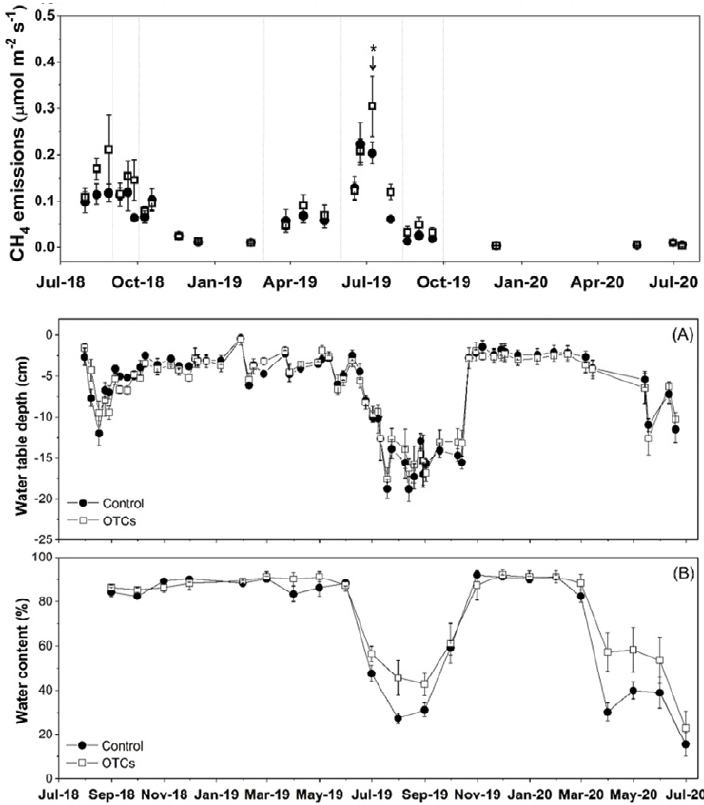
Comparative evolution of CH4 emissions (top), water table depth (middle) and water content (bottom) (Li et al.). Image Credit: ABB
The conclusion drawn from the study was that the mesocosms in both treatments – with or without warming – acted as a gaseous carbon source (34 and 14 gCm−2 yr−1, respectively) caused mainly by the strong net CO2 release from the mesocosms during a low WTD period in summer.
The result encouraged higher respiration and organic material decomposition under aerobic conditions. The study showed the heavy effect of moderate warming on the gaseous carbon fluxes of temperate peatlands and demonstrated that the gaseous carbon balance maintained stability over two years of moderate warming.
The study also stressed that the response of carbon fluxes to warming was largely dependent on the peatland’s WTD and vegetation composition. This emphasizes the imperative for sustained, long-term hydrological monitoring and the integration of data on WTD and vegetation changes alongside warming to accurately discern the impact of their interactions on peatland carbon fluxes.
References and Further Reading
- Li Q, Gogo S, Leroy F, Guimbaud C and Laggoun-Défarge F (2021), Response of Peatland CO2 and CH4 Fluxes to Experimental Warming and the Carbon Balance. Front. Earth Sci. 9:631368. doi: 10.3389/feart.2021.631368.

This information has been sourced, reviewed and adapted from materials provided by ABB.
For more information on this source, please visit ABB.